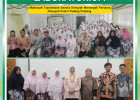MUHAMMAD NAZRI JANRA1 AND RICHARD NOSKE2 1Biology Department in Andalas University, Jalan Kampus Unand Limau Manis Padang, West Sumatra, Indonesia 25163. email: This email address is being protected from spambots. You need JavaScript enabled to view it.; 2Research Institute for the Environment and Livelihoods, Charles Darwin University, Darwin, NT, Australia, 0909.
Ringkasan: Telah teramati perilaku display “sayap patah” sebagai tindakan pengalih perhatian yang dilakukan oleh seekor Berencet Kecil (Pnoepyga pusilla) terhadap manusia pengganggu sarangnya, yang berlokasi pada jalur pendakian di Gunung Singgalang, Sumatera Barat. Perilaku display ini sepertinya menjadi yang pertama didokumentasikan untuk jenis ini, dan barangkali untuk marga Pnoepyga. Perilaku ini sendiri menegaskan bahwa predator sarang bagi burung ini utamanya bersifat diurnal. Sebelumnya hanya ada satu catatan perbiakan jenis ini yang dipublikasikan dari pulau Sumatera dan pengamatan ini merupakan yang pertama melaporkan tentang sarang jenis ini di pulau yang sama.
The tiny Pygmy Wren-babbler Pnoepyga pusilla is widely distributed, occuring from the Himalayan region to extreme Southeast Asia, including Flores and Timor. In Indonesia, this species is represented by four subspecies: lepida on Sumatra, rufa on Java, and the isolated everetti on Flores and timorensis on Timor (Collar & Robson 2007). Despite its wide geographical range, little is known about its breeding biology (Collar & Robson 2007), probably owing to its cryptic nature. DNA studies suggest that the genus Pnoepyga belongs in its own family (Pnoepygidae) instead of the babblers (Timaliidae) with which it is traditionally placed, and this separation is corroborated by its extremely short tail and almost flightless behaviour, rounded wings and ventral pattern and non-social behaviours (Gelang et al. 2009). On 1 November 2009, while conducting a mist-netting study, MNJ found an active nest of Pygmy Wren-babblers at c. 1,200 m asl on the northern side of Gunung Singgalang, Sumatera Barat (0°23’24”S, 100°19’51”E). The presence of a nest was suspected after a bird was inadvertently flushed from the same location at which it had been flushed twice on the previous day, when the observer and his co-workers passed by while traversing a trail leading to mist-nets. On each occasion that the Wren-Babbler was flushed from its nest it was observed hopping along the ground for c. 5 m away from the observers, dragging one of its wings, as if it was broken, for c. 10 s. It was assumed that the observed individual was trying to lure the observers away from its nest site, which narrowed down the search area. The nest was well-concealed, hanging from a vine that was growing along the bank of the trail, c. 50 cm above the level of the trail (Plate 1). It contained two immaculate white eggs (Plate 2). Typical for the species (cf. Collar & Robson 2007), the nest was spherical in shape with a small entrance at the top, and was built from fibres of ferns and other plants, fine rootlets and shoots of herbs. The interior was lined with much drier and finer palm fibres, while the exterior was covered with mosses, providing camouflage against the surrounding wet, mossy vegetation. Designed to distract nest predators from nests, broken-wing distraction displays are perhaps best known among plovers (e.g. Taufiqurrahman & Subekti 2013) and other shorebirds (Gochfeld 1984, in Caro 2005). They are most commonly found among noncolonial species that build inconspicuous nests in the open and/or on the ground, and
Kukila 18 (2) 2015 Short Communication 63
which are presumed to have diurnal nest predators, because such displays would be ineffective at night (Armstrong 1954, 1956). Clearly the Pygmy Wren-babbler exhibits most of these characteristics, though its nest predators are unknown. Such displays have been reported in at least three Asian babblers (Timaliidae) – the Black-capped Babbler Pellorneum capistratum and Abbott’s Babbler Malacocincla abbotti of Southeast Asia, including the Greater Sundas, and the Brown-capped Babbler P. fuscocapillus of Sri Lanka (Collar & Robson 2007). The two Pellorneum species are ground-nesters, whereas the Abbott’s Babbler typically nests 0.5 to 1.8 m from the ground (Collar & Robson 2007). On the Thai-Malay Peninsula, W.R. Davison described an apparent feigned-injury distraction display by a Black-capped Babbler flushed off its eggs, but no such behaviour has been reported at other nests of this species (Wells 2007: 344). Seng & Chew (2012) observed a nest of Sumatran-endemic Rusty-breasted Wren-babbler Napothera rufipectus and although the incubating bird was apparently aware of their presence it did not exhibit a distraction display. Our observation appears to the first record of this behaviour in the Pygmy Wren-babbler, and perhaps the genus Pnoepyga.
Although the Pygmy Wren-babbler is a common resident in Sumatra (Marle & Voous 1988), we know of only one previously published breeding record. An adult was observed feeding an immature bird in montane forest (2,200 m asl) on Gunung Kerinci on 27 December 1986 (Holmes 1996), which suggests nesting in November or early December, consistent with the nest described in this paper. While the main breeding season for most forest birds in the Greater Sundas is from March to June (Voous 1950), corresponding to the boreal spring and early summer, this species appears to breed for much of the year. In Java, there are breeding records from all months except June, though 71% of clutches (n=130) were laid from October to February, corresponding to the boreal autumn and winter (Hoogerwerf 1949; Hellebrekers & Hoogerwerf 1967). On the ThaiMalay Peninsula, on the other hand, egg-laying is thought to occur from mid-January to June (Wells 2007). The Sumatran records, therefore, seem to correspond more with the breeding season on Java than on the Asian mainland.
Acknowledgements MNJ thanks Aadrean, Liza Meini Fitri, Heru Handika for assistance during the field work, and Wilson Novarino for his advice prior to and after the field trip. We are indebted to Nagao Natural Environment Foundation (Nagao NEF) for supporting MNJ’s fieldwork through the Small Research Grant Scheme 2009-2011. We also thank Bas van Balen, Colin Trainor and Philippe Verbelen for providing references and constructive comments.
References Armstrong, E.A. 1954. The ecology of distraction display. Animal Behaviour 2: 121-135. Armstrong, E.A. 1956. Distraction display and the human predator. Ibis 98: 641-654. Caro, T. 2005. Antipredator Defenses in Birds and Mammals. University of Chicago Press, Chicago. Collar, N.J. & C. Robson. 2007. Family Timaliidae (Babblers). Pp 70-291 in del Hoyo, J., A. Elliott & D. Christie (eds.). Handbook of the Birds of the World, vol. 12: Picathartes to Tits and Chickadees. Lynx Edicions, Barcelona, Spain. Gelang, M., Cibois, A., Pasquet, E., Olsson, U., Alström, P. & P.G.P. Ericson. 2009. Phylogeny of babblers (Aves, Passeriformes): major lineages, family limits and classification. Zoologica Scripta 38: 225-236. Gochfeld, M. 1984. Antipredator behavior: aggressive and distraction displays of shorebirds. Pp 289-377 in Burger, J. & B.L. Olla (eds.). Shorebirds: Breeding Biology and Populations. Plenum Press, New York & London. Hellebrekers, W.P.J. & A. Hoogerwerf. 1967. A further contribution to our oological knowledge of the island of Java (Indonesia). Zoologische Verhandelingen 88: 1-164. Holmes, D.A. 1996. Sumatra bird report. Kukila 8: 9-56. Hoogerwerf, A. 1949. Contribution to the oölogie of Java. Limosa 22: 1-279. MacKinnon, J., K. Phillipps, & S. van Balen. 1998. Burung-burung di Sumatera, Jawa, Bali dan Kalimantan (The Birds of Sumatra, Java, Bali and Kalimantan). LIPI-Seri Panduan Lapangan, Bogor. (in Indonesian). Marle, J.G. van & K.H. Voous. 1988. The Birds of Sumatra: an Annotated Check-list. British Ornithologists’ Union, Tring, U.K. [BOU Check-list 10] Seng, L.K. & J. Chew. 2012. First nest and egg of the Sumatran-endemic Rusty-breasted Wrenbabbler Napothera rufipectus. Kukila 16: 53-55. Taufiqurrahman, I. & H. Subekti. 2013. Distraction behaviour of breeding Javan Plover Charadrius javanicus. Kukila 17: 17-21. Voous, K.H. 1950. The breeding season of birds in Indonesia. Ibis 92: 279-287. Wells, D.R. 2007. Birds of the Thai-Malayan Peninsula. Vol. 2. The Passerine Birds of Southern Thailand, Peninsular Malaysia and Singapore. Academic Press, London.








































































